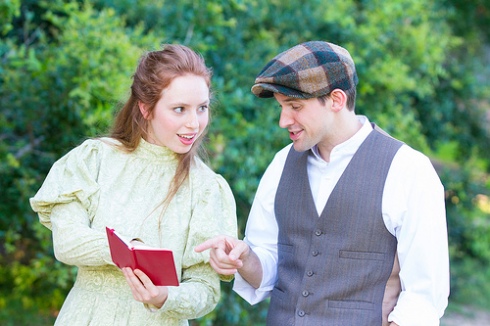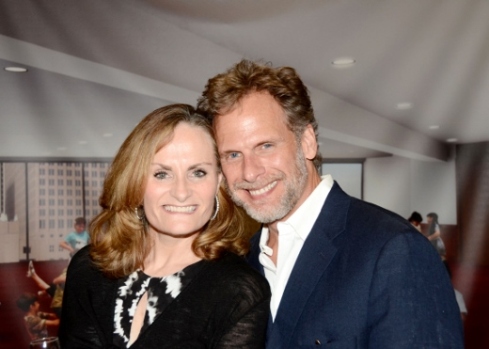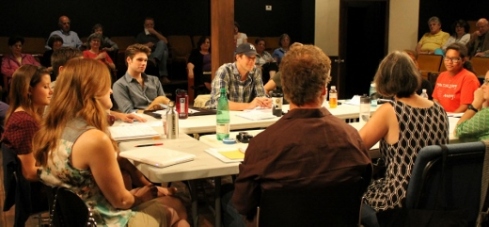
By HOLLY BERETTO
The trouble with A.D. Players’ charming mounting of Anne of Avonlea isn’t so much in the execution as in the source. The play is based on the book of the same name, a sequel to L.M. Montgomery’s phenomenally popular Anne of Green Gables, first published in 1908…and never out of print since, inspiring along the last century a couple of movie and stage adaptions and widely critically acclaimed miniseries. Two publishers rejected Montgomery’s manuscript and she stuck it in a drawer sometime in 1906, only to find it a year later weeding through her files. She re-read it, decided it wasn’t half bad after all, and shipped it off to L.C. Page and Co., who immediately bought it – and asked for a sequel.
“To-day [sic] I finished my second book…but I know it’s not really so good as Green Gables,” the author wrote in her diary of said sequel in August of 1908. And there, in a nutshell, is the issue.
It never works comparing a book to a movie or play – you’ll make yourself crazy. But in this instance the play tires so very hard to be exactly like the book that it wanders, vignette-like, without a coherent beginning, middle and end, and playwright Joseph Robinette, whose writing chops include a collaboration with E.B. White on adaptation of Charlotte’s Web and the book to the recent Tony Award-nominated A Christmas Story: The Musical, tries to string it all together with the tired convention of having Anne narrate the action as she writes the story of her life for a college entrance essay. It’s messy and meandering, calling to Anne to step outside the action and speak Montgomery’s narrative prose, which doesn’t sound half so lovely spoken as written, and makes for action-stopping interruptions in the pacing that grate.
But, what a lovely thing director Sarah Cooksey created trying to make it all work. It’s truly the perfect show for A.D. Players, a company known – and respected – for its family fare with keen edge for the spiritual. L.M. Montgomery was a minister’s wife, and all of her works –not just the Anne series – are imbued with both an underlying and unpretentious sense of faith and spiritually, as well as a delight in the natural world. In Anne of Avonlea, our beloved red-headed heroine is 16, and about to spend two years teaching school before heading off to Redmond College, “navigating the tricky path between girlhood and womanhood,” as Cooksey offers in her Director’s Note. This is a play ripe for A.D. Players’ touch.
And it has its beautiful moments. Rising HSPVA senior Joy Spence heads the cast as Anne, and she has sparks of perfect brilliance, especially in her interaction with her favorite pupil, Paul (played with day-dreamingly imaginative charm by Dylan Klinge) and her scenes with cranky neighbor Mr. Harrison (a rally delightful Chip Simmons). But her performance is uneven, and she never quite seems natural inside Anne’s delightful whimsy and sense of wonder. She does, however, deserve some serious props for the sheer force and effort it takes to harness all of Anne’s dialogue – and fans of Anne will remember that Anne is, as they say, a talker.
Patty Tuel Bailey as Anne’s adoptive mother Marilla is a foil for the “red-headed snippet’s” exuberance and castles-in-the-air, bringing a dry wit and occasionally soft touch to her character’s brittle exterior. Stephanie Bradow pulls double duty as helicopter mom Mrs. Donnell and busybody neighbor Rachel Lynde; she’s roaringly hilarious in the former if a trifle cliché in the latter. Oceans of ink have been spilled over Montgomery’s over-populating her works with women – and what strong, multi-layered women they are – (anyone looking for essays or scholarship on such should pick up Elizabeth Rollins Epperly’s The Fragrance of Sweet Grass or a host of writing by Irene Gammel) leaving the guys to come off as minor at best. Anne’s not-quite-love-interest Gilbert Blythe, played by Jason Hatcher, suffers this fate. Hatcher’s fine, but he hasn’t much to work with.
And that’s what we keep coming back to here. The story is episodic and often lyrical, evoking a simpler time and place. But there isn’t a lot of there there. Cooksey maneuvers her ensemble cast – including two separate casts of various children – through each scene, but it never feels like a continued storyline – although, if it does, it’s the storyline you already know from Anne of Green Gables. Eric Domuret’s sound design feels more like rural Appalachia than late-Victorian Canada, and Donna Southern Schmidt’s costumes have some nice touches, but they seem more generic than specific. As a nitpicky wannabe-Anne scholar, I take issue with the setting as being the early 1900s, although that is likely not A.D. Players’ fault (In the early 1900s, Anne is in her 20s, because in the brilliant Rilla of Ingleside, the very last book in the Anne series, World War I is raging and Anne sends her sons off to fight in it, meaning there is no way she can be 16 in 1900 and have sons old enough to go to war in 1914).
For all the trouble of the play’s material and writing, however, it’s a tremendously well-done effort. The company clearly conveys its delight in doing the piece, and Cooksey’s marshaling of a huge cast, many playing multiple roles, is quite good. There’s a terrific rendering of a scene where all the children are writing Anne letters as an assignment – each of them offering a mini-monologue as they write, their essays tumbling over each other, that’s an excellent rendering of that scene in the book. The romanticism that’s so clearly the foundation of Anne’s story is largely intact and the cast as a whole is engaging.
In all, not a bad way to spend an afternoon or evening. While it may not have, as Anne would say, “scope for the imagination,” it really does prove that A.D. Players is a whole company of “kindred spirits.”








